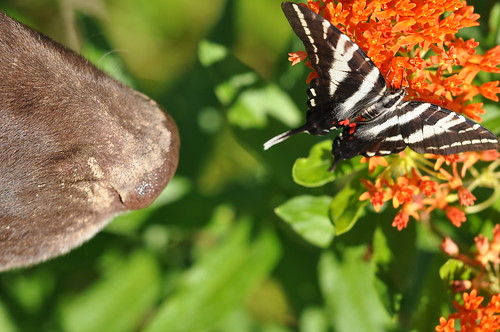The Zebra Swallowtail Butterfly (Eurytides marcellus, other authorities list the species under genera in the family including Iphiclides, Graphium and Papilio) is a swallowtail butterfly found in the eastern United States, north-east Mexico and south-east Canada. Its distinctive black and white-striped pattern is reminiscent of a zebra.
The Zebra Swallowtail Butterfly is also the official state butterfly of Tennessee.
The Zebra Swallowtail has triangular wings with long tails. It has some distinctive black and white markings on its wings and some small red and blue markings on both bottom corners of the wings. There are two seasonal forms. Spring forms are more white and have small black tails with white tips. Summer forms are more black and have longer tails with more white in them. The wingspan measures 2 2/5 to 3 1/2 inches.
Males will patrol to find females. Females lay their eggs singly on pawpaw leaves and occasionally on the tree trunks. The egg is pale green but within 3 days it turns an orange-brown color, and then it turns dark gray just before hatching. The larvae are cannibalistic.
Young larvae are black. Older larvae have two different color forms. The more common form is green with yellow and white transverse stripes. Between the thorax and the abdomen is a tricolor band with yellow toward the abdomen, black in the middle, and a bluish-white color toward the thorax. The more rare form is black with white and orange transverse stripes.
The larva has a foul-smelling, forked gland called an osmeterium which it will use to deter predators. The chrysalis is either green or brown and is more compact compared to chrysalids in the genus Papilio. The chrysalis overwinters. It has 1-2 broods per year in the north and 3-4 broods per year in the south.
The Zebra Swallowtail Butterfly is also the official state butterfly of Tennessee.
The Zebra Swallowtail has triangular wings with long tails. It has some distinctive black and white markings on its wings and some small red and blue markings on both bottom corners of the wings. There are two seasonal forms. Spring forms are more white and have small black tails with white tips. Summer forms are more black and have longer tails with more white in them. The wingspan measures 2 2/5 to 3 1/2 inches.
Males will patrol to find females. Females lay their eggs singly on pawpaw leaves and occasionally on the tree trunks. The egg is pale green but within 3 days it turns an orange-brown color, and then it turns dark gray just before hatching. The larvae are cannibalistic.
Young larvae are black. Older larvae have two different color forms. The more common form is green with yellow and white transverse stripes. Between the thorax and the abdomen is a tricolor band with yellow toward the abdomen, black in the middle, and a bluish-white color toward the thorax. The more rare form is black with white and orange transverse stripes.
The larva has a foul-smelling, forked gland called an osmeterium which it will use to deter predators. The chrysalis is either green or brown and is more compact compared to chrysalids in the genus Papilio. The chrysalis overwinters. It has 1-2 broods per year in the north and 3-4 broods per year in the south.





No comments:
Post a Comment